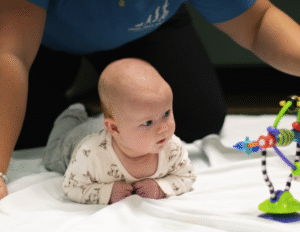Drop foot, also known as foot drop, happens while walking. It is when a person has difficulty lifting the front part of their foot which then drags on the ground while walking. It is not a disease, but rather an underlying condition. Due to the front part of a person’s foot being more difficult to lift, a person with drop foot will usually compensate by using their hip flexors (raising their thigh) as if they were walking up the stairs, in order to help their foot clear the ground.
Drop foot could be caused by weakness or paralysis of the muscles involved in lifting the front part of the foot (Tibialis Anterior). The most common cause is a nerve injury that compresses the peroneal nerve in the leg which controls the muscle to complete the intended movement. Some muscle disorders that can contribute to drop foot are: muscular dystrophy, brain and spinal cord disorders, amyotrophic lateral sclerosis (ALS), multiple sclerosis or stroke. Some risk factors to drop foot would be activities that may compress the peroneal nerve. These activities may include: crossing your legs, prolonged kneeling or wearing a cast. It is important to be aware of posture as well as changing positions often to prevent any prolonged compression on this nerve.
Treatment for drop foot depends on what is causing it happen in the first place. Depending on the cause, it may be treated, and symptoms can improve or even disappear completely. Your doctor may order a brace splint that will fit into your shoe to help hold your foot in a neutral position. Physical therapy can help by strengthening your muscles and help maintain the range of motion in your knee/ankle which may improve gait problems associated with foot drop. It is also important to incorporate stretching to prevent any stiffness in the heel. In more severe cases surgery may be appropriate. Some surgical options may be fusing the ankle/ foot bones together, or transferring a working tendon and attaching the muscle to a different part of the foot.
Because foot drop increases your risk of tripping or even falling, it is highly recommended to decrease that risk as much as possible by implementing the following:
- Keep all floors clear of clutter.
- Avoid the use of throw rugs.
- Move electrical cords away from walkways.
- Make sure rooms and stairways are well-lit.
- Place fluorescent tape on the top and bottom steps of stairways.
Contact your doctor if you think you might have foot drop to start getting the proper care and treatment.
Once consulting with your doctor call for a FREE screening with one of our Physical Therapists
586-323-2957
-Brie Glombowski, PTA



